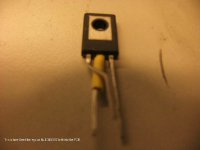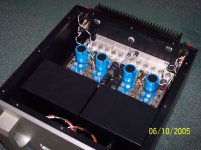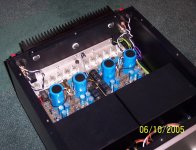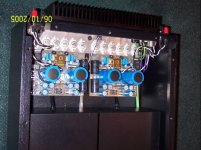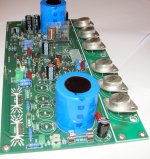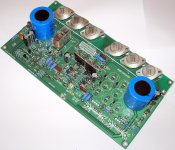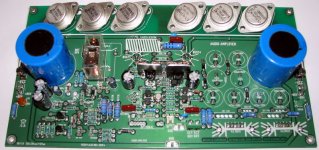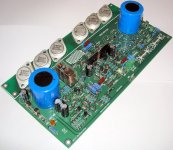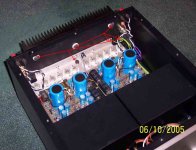That looks nice😀
Still it would be nice to have all the drivers/predrivers on the same heatsink.

Still it would be nice to have all the drivers/predrivers on the same heatsink.
Hi,
Quite possibly. I have not looked at either the datasheets or attempted to build the circuit using these, so I cannot comment. Why don't you try it?
I am unsure if you want a common heatsink. A common heatsink for any given pair, yes, for all? Maybe.
But the Drivers definitly belong onto the output heatsink if any, where they partially compensate the Fets Tempco...
Ciao T
If you keep the driver voltage below +/- 75 V wouldn´t the pair 2sc3423/2sa1360 be a good substitute for BSS71/74?
In fact maybe for the MPSA types as well? The 2sc3423 has even lower Cob (1,5 pf) and 2sa 1360 has 2,5 pf.
Quite possibly. I have not looked at either the datasheets or attempted to build the circuit using these, so I cannot comment. Why don't you try it?
They are in TO126 house , so it is far easier to place all drivers/predrivers on a common heatsink.
I am unsure if you want a common heatsink. A common heatsink for any given pair, yes, for all? Maybe.
But the Drivers definitly belong onto the output heatsink if any, where they partially compensate the Fets Tempco...
Ciao T
Last edited:
Kolby
This is how I mounted T7-T10 on a common heatsink and how I had to bent their legs.
I use MJE340/50 instead of MPSA42/92. Arguments for this have been discussed in a earlier post on this thread.
If you go for MJE 340/50 instead of BSS71/74 I think it could be possible to also incorpulate drivers on the same heatsink, but do we really wish that(ref. ThorstenL)??
Eivind Stillingen
This is how I mounted T7-T10 on a common heatsink and how I had to bent their legs.
I use MJE340/50 instead of MPSA42/92. Arguments for this have been discussed in a earlier post on this thread.
If you go for MJE 340/50 instead of BSS71/74 I think it could be possible to also incorpulate drivers on the same heatsink, but do we really wish that(ref. ThorstenL)??
Eivind Stillingen
Attachments
See post #1751
I think in another post someone strongly recomends to put drivers and predrivers on the same heatsink, but I can´t find it now.
I am not sure if it is a good idea to put them on the same heatsink as the MOSFets as they change to negative tempco at some point. If it was BJT output, then it would be adviseable.
I think in another post someone strongly recomends to put drivers and predrivers on the same heatsink, but I can´t find it now.
I am not sure if it is a good idea to put them on the same heatsink as the MOSFets as they change to negative tempco at some point. If it was BJT output, then it would be adviseable.
Golmund clone
Foto Mimesis 9
Foto Mimesis 9
Attachments
Last edited:
Hi,
Actually, I would view this differently.
But anyway, an ideal situation is that output stage tempco is zero. The BJT is positive and with more than around 100mA Iq per pair the Mosfets are negative tempco. The negative tempco increases with current.
So using a BJT on the same heatsink can likely give near zero Tempco at around 300mA per pair.
Ciao T
I am not sure if it is a good idea to put them on the same heatsink as the MOSFets as they change to negative tempco at some point. If it was BJT output, then it would be adviseable.
Actually, I would view this differently.
But anyway, an ideal situation is that output stage tempco is zero. The BJT is positive and with more than around 100mA Iq per pair the Mosfets are negative tempco. The negative tempco increases with current.
So using a BJT on the same heatsink can likely give near zero Tempco at around 300mA per pair.
Ciao T
Hi,
The poster in these posts is off base on several counts.
First, the IPS ccs is temperature compensated on the Goldmund, so there is no drift here.
The only drift comes from the VAS Transistors.
The current mirror is also compensated for termperature changes (by it's nature).
Given that the VAS Transistors run hot (which improves their parameters incidentally) their sensitivity to external temperature changes is reduced and as they are quite substantially degenerated the temperature snesitivity is much decreased.
As designed by Goldmund I would estimate that the VAS shows less than 0.1mA change in current in each VAS transistor for a 20 degree change in ambient temperature for the whole frontend. Placing all parts on the same heatsink will not really change this situation.
By inserting two diodes in series with the IPS Load resistors this could be compensated full, equally by adding a pair of NPN Trasistors as VAS Buffer (which would also improve other parameters), either case needs changing the tail resistor of the VAS, however even as is I would not loose sleep.
Ciao T
Common heatsink:Look at #1652-1655.
The poster in these posts is off base on several counts.
First, the IPS ccs is temperature compensated on the Goldmund, so there is no drift here.
The only drift comes from the VAS Transistors.
The current mirror is also compensated for termperature changes (by it's nature).
Given that the VAS Transistors run hot (which improves their parameters incidentally) their sensitivity to external temperature changes is reduced and as they are quite substantially degenerated the temperature snesitivity is much decreased.
As designed by Goldmund I would estimate that the VAS shows less than 0.1mA change in current in each VAS transistor for a 20 degree change in ambient temperature for the whole frontend. Placing all parts on the same heatsink will not really change this situation.
By inserting two diodes in series with the IPS Load resistors this could be compensated full, equally by adding a pair of NPN Trasistors as VAS Buffer (which would also improve other parameters), either case needs changing the tail resistor of the VAS, however even as is I would not loose sleep.
Ciao T
there is still wrong :where is 53K6?
What do you mean? please explain?
Hi Everyone
It must be sounding good , by the way is there any differences using a common driver and ecah mosfet drived by a seperate BJT ?
Regards
It must be sounding good , by the way is there any differences using a common driver and ecah mosfet drived by a seperate BJT ?
Regards
Hi Everyone
It must be sounding good
Regards
if you are lucky its just as good as any other amp 😉
man, its a stupid title

From my experience I have of this amp is a very good amps if they faithfully follow the diagram for the materials. Very good audibility constant offset although now that the ambient temperature has now fallen, etc.
Alex has done a great job as usual.
Nagys verified for all those who had supported.
I wonder if anyone can explain practically what makes up the characteristic Mechanical Grounding?
Alex has done a great job as usual.
Nagys verified for all those who had supported.
I wonder if anyone can explain practically what makes up the characteristic Mechanical Grounding?
I wonder if anyone can explain practically what makes up the characteristic Mechanical Grounding?
It is a way of attenuate vibrations according to Goldmunds white paper.
See attachment. It also seems to be patented?
Attachments
And is there any proof it helps ( real experimental data, or some numbers) or just a bunch of marketing babble? That white paper is about as useful as the white paper in my bathroom.
😀 I tend to agree. But (I'm not kidding here): There is a little region in the brain called 'nucleus accumbens'. It's very susceptible for e.g. marketing babble and especially for high price tags. It might even let you think you're listening to "The Very Best Amplifier I Have Ever Heard!!!!" (sic). 😉
You guys really need to build amps!
For some people like me, we like lateral mosfets, not because it is expensive 😀 Then not many good lateral mosfet amps you can find commercially or even DIY. So to get the best out of your amp, you have to pay attention to the details. And grounding is very important. It's not marketing hype. You just need to build the best amp you can.
I always use over-rated transformers. I believe that even if my amp is only rated 50W, it should be capable of delivering a lot higher current for short term music signal. And in practice, over-rated transformers do give benefits.
Look carefully at how the amp has been built, or build it yourself according to the spec, and I would be very happy if you guys can show me a better amp, according to your own listening test/experience.
Just tell me who you are, and which amps you have compare side by side, and tell me which one is the winner. If I found that you are one of the DIYer with good ears, I will surely build your amp recommendation (Hopefully it is not the ExtremA or PGP 😛)
For some people like me, we like lateral mosfets, not because it is expensive 😀 Then not many good lateral mosfet amps you can find commercially or even DIY. So to get the best out of your amp, you have to pay attention to the details. And grounding is very important. It's not marketing hype. You just need to build the best amp you can.
I always use over-rated transformers. I believe that even if my amp is only rated 50W, it should be capable of delivering a lot higher current for short term music signal. And in practice, over-rated transformers do give benefits.
Look carefully at how the amp has been built, or build it yourself according to the spec, and I would be very happy if you guys can show me a better amp, according to your own listening test/experience.
Just tell me who you are, and which amps you have compare side by side, and tell me which one is the winner. If I found that you are one of the DIYer with good ears, I will surely build your amp recommendation (Hopefully it is not the ExtremA or PGP 😛)
- Home
- Amplifiers
- Solid State
- The Very Best Amplifier I Have Ever Heard!!!!

